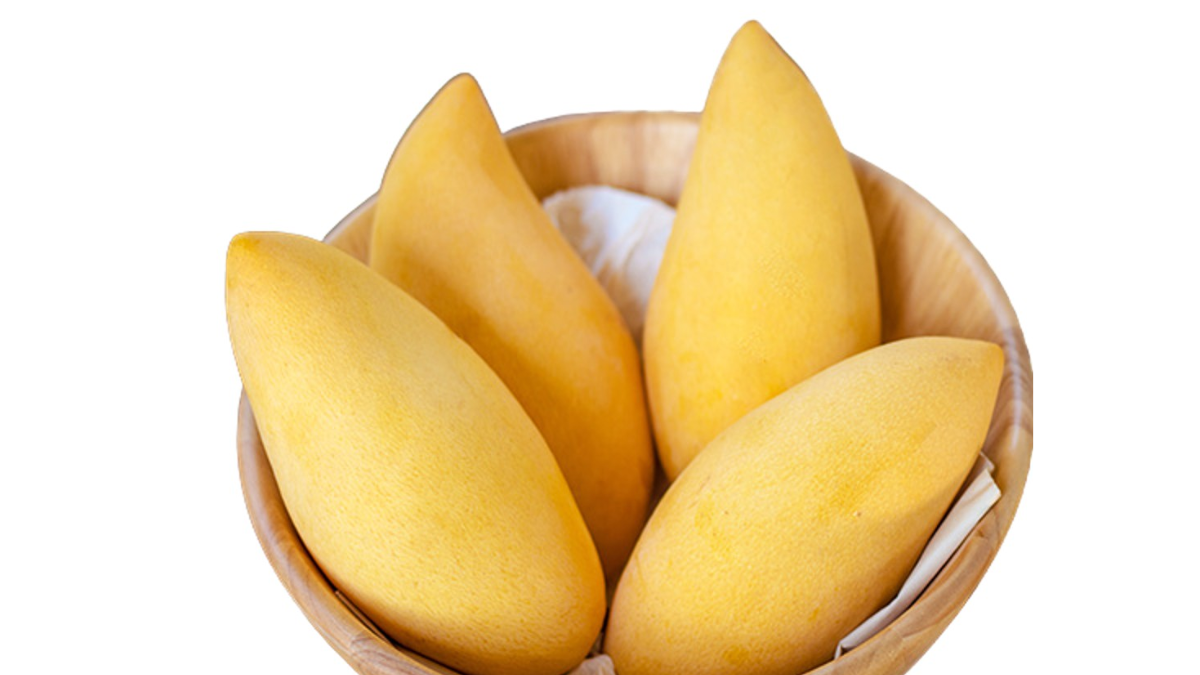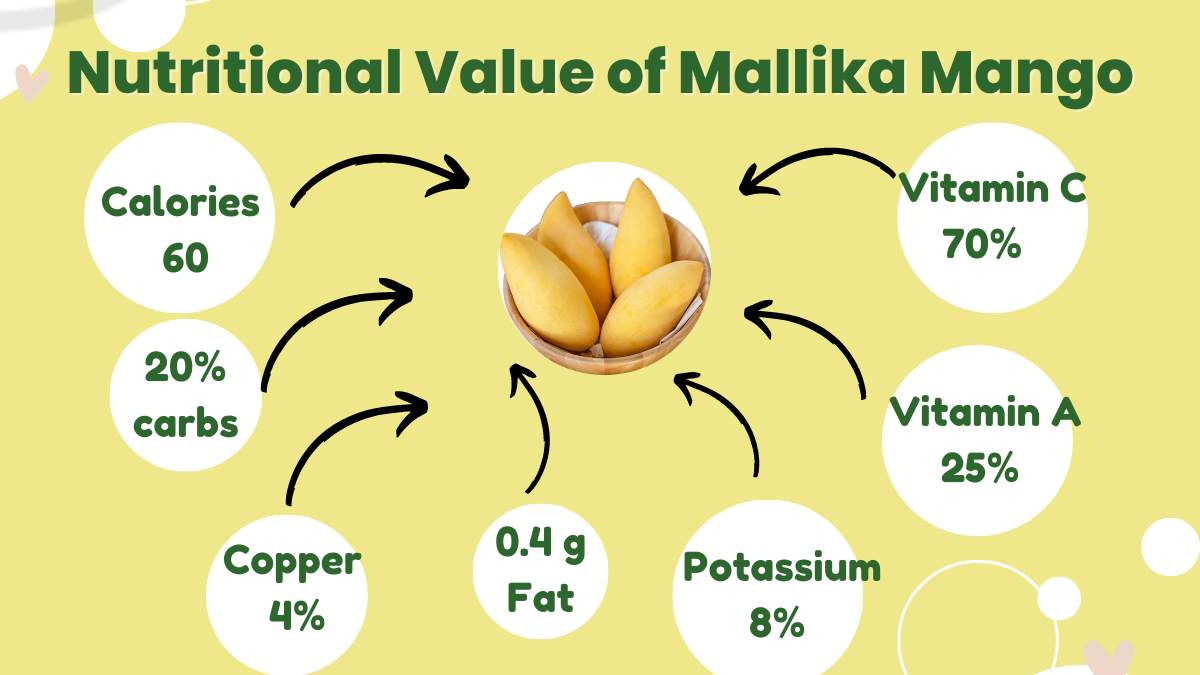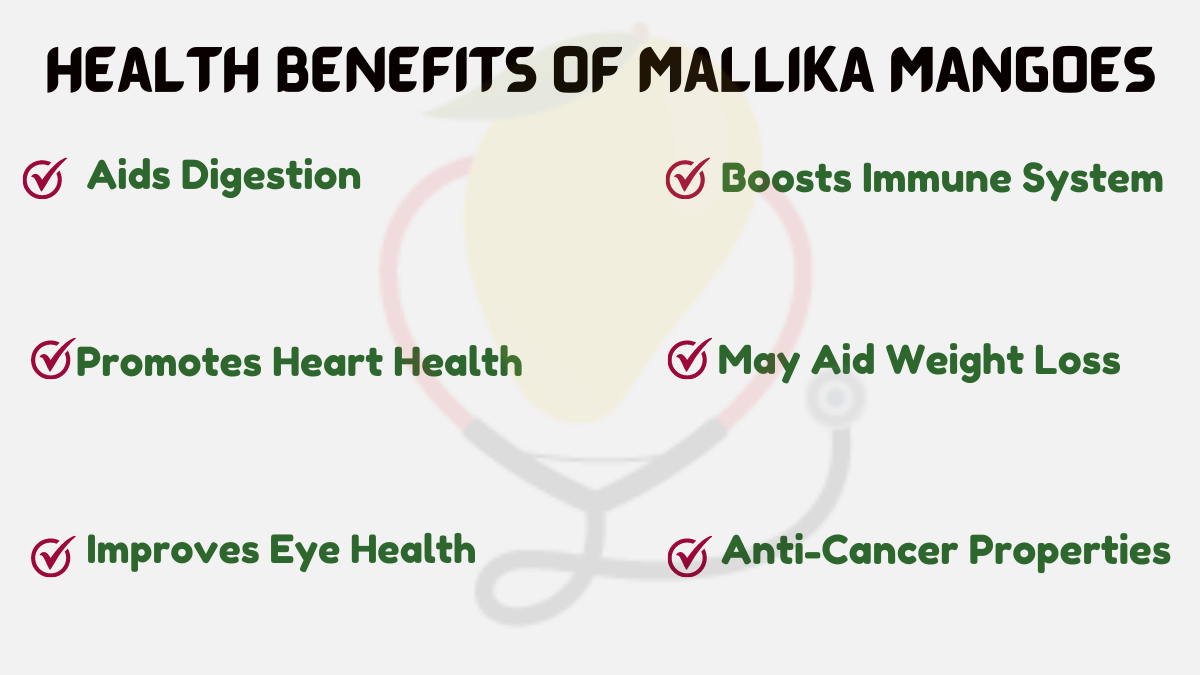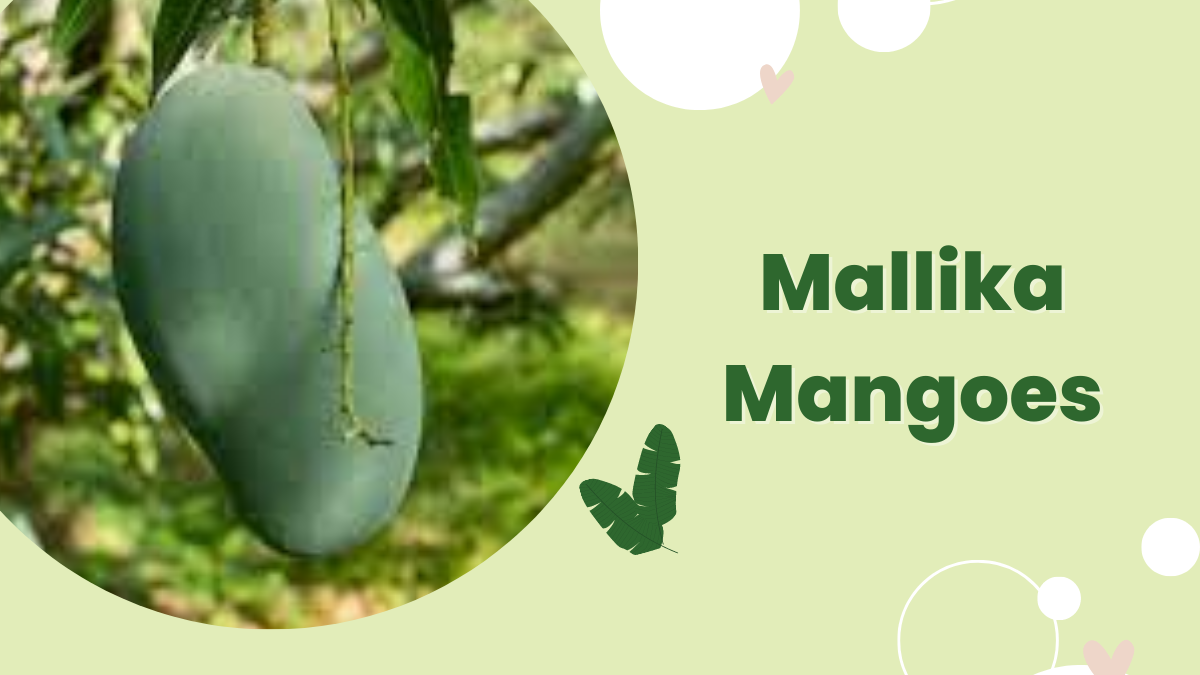Mallika mango are a variety of mango that is known for its deliciously sweet taste and aromatic flavor. This type of mango is popular in India and has gained popularity worldwide due to its unique taste and texture. [1]
In this article, we’ll provide you with everything you need to know about Mallika mangoes, including their history, nutritional benefits, and how to eat and store them.

History of Mallika Mangoes
Mallika mangoes were first developed in 1986 in India by Dr. Pijush Kanti Majumdar, who was a horticulturist at the Indian Agriculture Research Institute. Dr. Majumdar developed the Mallika mango by crossbreeding the Neelum and Dasheri mango varieties, which are both native to India.
The Mallika mango was developed to address the issues of disease susceptibility and poor shelf life that were common in other mango varieties.
The Mallika mango is resistant to disease, has a longer shelf life, and has a unique taste and texture that makes it stand out from other mango varieties.
Appearance and Taste
- Mallika mangoes are medium-sized, weighing around 250-300g, with an oval shape and greenish-yellow skin.
- The skin is thin and smooth, and the flesh inside is deep orange and juicy.
- When ripe, the mango has a sweet and aromatic flavor with a hint of tartness, making it a perfect balance of flavors.
Characteristics of Mallika Mangoes
- Mallika mangoes are medium-sized, averaging about 300-500 grams each.
- They have an oblong shape, with a slight curve at the stem end.
- The skin of Mallika mangoes is smooth and thin, with a bright yellow-orange color when ripe.
- They have a small, narrow seed in the center of the fruit.
- The flesh of Mallika mangoes is firm, juicy, and fiberless, with a sweet and slightly tangy flavor.
- When sliced, the flesh of Mallika mangoes is a bright golden-yellow color.
- The aroma of Mallika mangoes is sweet and tropical, with hints of pineapple and citrus.
Nutritional Value of Mallika Mangoes
Mallika mangoes are a good source of nutritional benefits. [2]
Here are the nutritional values in percentage of Mallika mangoes.

- Carbohydrates: 20%
- Dietary fiber: 10%
- Vitamin A: 25%
- Vitamin C: 70%
- Folate: 10%
- Potassium: 8%
- Copper: 4%
- Calcium: 2%
- Iron: 2%
Health benefits of Mallika Mangoes
Here are some health benefits of Mallika mangoes.

1: Rich in Nutrients
Mallika mangoes are a rich source of vitamins A, C, and E, as well as dietary fiber, potassium, and folate. [3] These nutrients are essential for overall health and can help support a healthy immune system, promote heart health, and improve digestion.
2: Boosts Immunity
The high levels of vitamin C in Mallika mangoes can help boost your immune system and protect your body from infections and diseases. [4] It also helps in the production of collagen, which is important for skin health.
3: Aids Digestion
The dietary fiber [5] in Mallika mangoes can help promote healthy digestion and prevent constipation. It also supports the growth of healthy gut bacteria, which is important for a healthy digestive system.
4: Promotes Heart Health
The potassium in Mallika mangoes can help lower blood pressure [6] and reduce the risk of heart disease. The high levels of antioxidants in mangoes can also help protect the heart by reducing inflammation and oxidative stress.
5: Improves Eye Health
The vitamin A [7] in Mallika mangoes can help improve eye health and prevent age-related macular degeneration, a common eye condition that can cause vision loss.
6: May Have Anti-Cancer Properties
Some studies [8] suggest that the antioxidants in Mallika mangoes may have anti-cancer properties and can help protect against certain types of cancer, such as breast and colon cancer.
7: May Aid Weight Loss
Mallika mangoes are low in calories and high in fiber, [9] making them a great snack for people trying to lose weight. The fiber in mangoes can help you feel full for longer, reducing the urge to snack between meals.
Uses of Mallika Mangoes
Fresh Consumption: Mallika mangoes can be enjoyed fresh, either on their own or in combination with other fruits as a fruit salad.
Culinary Uses: Mallika mangoes are popularly used in various culinary preparations, such as jams, jellies, chutneys, pickles, juices, smoothies, ice creams, and sorbets. They add a unique tropical flavor to the dishes they are used in.
Dried Mangoes: Mallika mangoes can also be dried and preserved, either as whole slices or as pieces. Dried mangoes are a great snack option, and can also be used in baking and cooking.
Mango Pulp: The pulp of Mallika mangoes can be extracted and used in cooking or baking, such as in cakes, pastries, or curries.
Mango Slices: Mango slices can be used to garnish desserts, salads, or drinks.
Mango Puree: Mango puree can be used as a base for cocktails or as an ingredient in various sauces.
Mango Butter: Mango butter, made from the seed of Mallika mangoes, is used in cosmetics and skincare products for its moisturizing properties.
Traditional Medicine: Mallika mangoes have also been used in traditional medicine to treat various ailments, such as diarrhea, fever, and asthma.
Agricultural Uses: Mallika mangoes are a popular crop for commercial farming due to their resistance to diseases and pests, making them an important agricultural product in India.
Delicious Recipes of Mallika mangos
Here are two delicious recipes using Mallika mangoes.
Mallika mangoes are a delicious and nutritious fruit that can be enjoyed in many ways. They are rich in vitamins, minerals, antioxidants, and fiber, making them an excellent addition to a healthy diet.
Whether you enjoy them fresh, in a smoothie, or in a savory dish, Mallika mangoes are sure to satisfy your taste buds and provide numerous health benefits.
FAQs
What is the origin of Mallika mangoes?
Mallika mangoes were developed by the Indian Agricultural Research Institute in 1986.
What does a ripe Mallika mango taste like?
A ripe Mallika mango has a sweet and aromatic flavor with a hint of tartness.
What are the nutritional benefits of Mallika mangoes?
Mallika mangoes are rich in vitamins, minerals, antioxidants, and fiber, making them an excellent addition to a healthy diet.
How do you store Mallika mangoes?
Mallika mangoes should be stored at room temperature until they are ripe, then they can be refrigerated for a few days.

